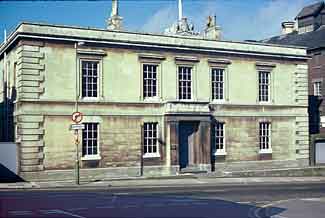 Construction Construction
The Canal Company agreed to sell the
site in February 1843, but it took over a year to complete the legal
formalities. Eventually, contractors Thomas Haines & Son were
given permission to start work in April 1844, and in spite of a
late decision to face the walls with Painswick stone instead of
brick, the building was roofed by October. During December, arrangements
were made to insure the building, and authority was given for employing
a person to light fires and to attend to the same. Meanwhile work
continued on the inside, including an alteration of the door between
the Comptroller's office and the Long Room where the clerks were
to work. The final payment to the contractor in September 1845 brought
the total cost to £4556. In addition, the Canal Company was
paid £567 for the land, and the Treasury authorised £657
to be spent on fittings and furniture for the offices.
Customs Officers
The
building was occupied by the Collector of Customs and his staff,
who were mainly responsible for recording cargoes brought to Gloucester
from foreign ports and for collecting the customs duty payable on
those goods. Some clerks undertook the registration of locally owned
vessels on behalf of the Board of Trade and maintained service records
of the masters and crews who served in these vessels. During the
19th century, part of the building was lived in by one of the customs
officers. Although the handling of foreign cargoes mainly moved
to Sharpness, the Gloucester custom house continued as an administrative
office until the late 1970s.
 A
New Role A
New Role
After the customs
staff moved out, the building took on a new role as the headquarters
of the Gloucestershire Regiment, including the regimental museum
which was opened in 1980 by HRH Duke of Gloucester, Colonel-in-Chief
of the regiment. Initially the entrance to the museum was from Commercial
Road, but in view of the redevelopment of the docks for leisure
and following a public appeal, the museum was reorganised and reopened
in 1990 with an entrance at what had been the back of the original
building. For more information about the museum, click here.
Main sources: PRO CUST 31/169-188, CUST 42/65 and RAIL 829/8-9;
Citizen 30 Oct 1980, 25 Jun 1990. |